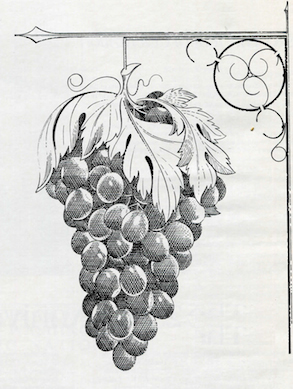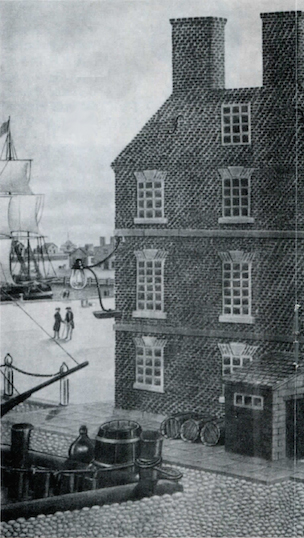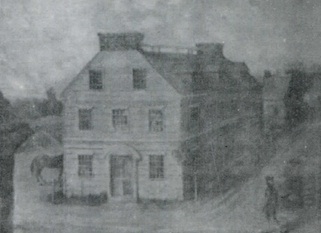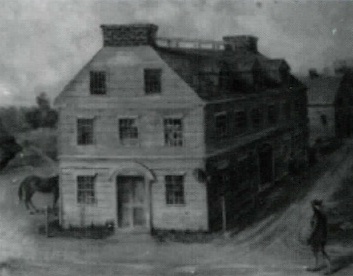MABunchOfGrapes
BUNCH OF GRAPES TAVERN

FROM TROWEL, 1983
From TROWEL, Vol. I, No. 1, 1983:

A 'Phantasy' by Lou King
A Visit to the Bunch of Grapes
My "time machine" has given me many opportunities to return to the past. It has been a dozen or so years since I wrote of my trip to London to bring Brother James Anderson to my Lodge for a visit and nearly that long since I wrote about the Fellowcraft who went to see King Solomon's Temple at Jerusalem.
Since then, however, technology has allowed me to build more advanced time capsules that will provide more space for a larger crew. Hop aboard as we journey back to old Boston. We'll set the dial for 250 years — and away we go.
Here we are in Boston on July 29, 1733. There is King Street. Look at the gilded bunch of grapes hanging over the doors of the Bunch of Grapes Tavern. Let's see if I can engage a room there. From my clothing, the innkeeper thinks I am a foreigner. So he recommends the shop of a merchant tailor named Henry Price who often has ready-made clothing to meet the needs of shipwrecked seamen who lose all they own before they are rescued.
So, off we go to see the very person I had come to interview. In the process of being measured for my new outfit, he is intrigued by my Masonic ring, saying he has never seen one like it before. I am able to satisfy him that I am really a Freemason although I seem to know much more than he does. When I say I have come with the express purpose of attending the meeting he had called for the morrow and at the very place where I am staying, he is completely flabbergasted. Upset and confused by the amount and nature of what I tell him, he doesn't at first know what to do about this stranger who knows so much. It is beyond anything he has ever experienced before. I succeed in reassuring him that I have absolutely no power to change in any way what would be said or done at the meeting, nor the slightest desire to change even a word.
I impress on him in the strongest manner that he is making history. I tell him that in his own century, the Colonies on the seacoast of North America would dissolve their allegiance with Britain and form a new nation, spreading across the continent to the shores of the Pacific Ocean, 3000 miles away. He is stunned by those revelations. When I say that his work tomorrow would grow to be known as the Most Worshipful Grand Lodge of Masons in Massachusetts, the third oldest of such Grand Lodges in the entire world, junior in rank only to the premier Grand Lodge of England and the Grand Lodge of Ireland, he is overwhelmed.
I advise him to not dwell on the things he has heard but to go about the business at hand as though I had never existed. He promises to try mightily to do that. To help him clear my mind I begin asking questions about how he came to be chosen to present the petition he carried to the Grand Master in London. He says that there are not many-Freemasons in New England, most of whom come from Gentlemen's Lodges in England.
Price had come to Boston, a highly skilled journeyman tailor who had earned the right to be called a Master Tailor and as such, to join a Gentlemen's Lodge. As owner of his business in Boston, he is entitled to be known as Mr. Price.
The next afternoon as the Masons are gathering, Mr. Price introduces me as an acquaintance from England and I sit silently in a remote corner observing. There is no great throng in the room Mr. Price has rented. But those who are here give an impression of inflexible determination to follow the principles of Freemasonry and the rules of conduct as laid down by Grand Lodge.
It nowhere appears in any of the histories I have read that any of the men assembled here have the faintest notion of what is to transpire this afternoon. But it soon becomes evident that Mr. Price has been very busy in the three months since his return from London.
As our written histories would have us believe, Henry Price waited for three months and then suddenly — almost as if on the spur of the moment — called the Masons together to form his Provincial Grand Lodge. No fuss, no bother, no questions. But human nature does not work that way. These are busy men who cannot be summoned at the snap of a finger.
I open a conversation with one brother who seems to be well aware of the situation, and he tells me that, since April, Mr. Price had held many meetings. In England, Provincials were quite often casually appointed, given no powers and seldom desired anything beyond the title. But Mr. Price knows that his would be an entirely different situation. Access to London is difficult, often requiring weeks of travel on the turbulent Atlantic. Therefore, he must be given extraordinary authority to make local regulations; to charter lodges; to impose quarterages and fees to meet the financial demands of operating a Grand Lodge; to impose penalties for infractions of regulations; to control the behavior of private lodges and the individual members.
Thomas Kennelly, who is to be installed Senior Grand Warden today, tells me that the Masons of Boston have been meeting, as a lodge, unchartered, under the time immemorial ancient custom of Masons, for some time but they had learned of the new Grand Lodge at London, growing yearly in strength and popularity. When Mr. Price said he was leaving on a business trip to England, they gave him a petition, addressed to the Grand Master, praying that they be regularized with a charter. Price presented the petition but went one step further. Knowing the vicissitudes of overseas communications, Price obtained a commission appointing him "Provincial Grand Master of New England aforesaid and Dominions and Territories thereunto belonging with full power and Authority.
He is empowered with almost all the abilities of the Grand Master himself, unusual at that time and which Price is careful not to abuse.
So, as Price reads his commission, he formally opens his Provincial Grand Lodge. He then appoints his staff of Grand Officers, following closely those of the Grand Lodge itself, an unusual procedure but necessary in view of the distance from London and its consequent delays.
All that remains is the formal presentation of the petition for a charter for the Lodge of Masons meeting in Boston. This is promptly granted, the Lodge officers are installed, and America's First Lodge of Masons is duly chartered and ready for such business as may regularly come before it. Grand Master Price then closes his Grand Lodge in ample form. The First Lodge follows suit and that historic July 30, 1733, is given over to feasting and celebration.
It had been a long and memorable day and I am tired, so I congratulate Brother Price on a flawless ceremony, bid farewell, and retire to my room.
In the morning I pack my bag and climb the hill to the capsule when I meet a furious old gentleman who demands to know by what right I had erected that contraption and insists that I remove it at once. I hop aboard and vanish before the astounded eyes of old Mr. William Hancock. A few seconds later, I find myself seated at my own kitchen table waiting for my breakfast.
FROM TROWEL, 1992
From TROWEL, Spring 1992, Page 29:
A View of Boston and the Bunch of Grapes Tavern
By R. W. James T. Watson, Jr.
What was Boston like when regular Masonry on this continent began at the Bunch of Grapes Tavern on July 30, 1733? At this time, the only approach to Boston by land was from the south, the town being at the north end of a peninsula into Boston Harbor. During storms or high tides it became an island when water from the harbor flowed over "the Neck". On the right was Roxbury Harbor, on the left, the Back Bay of the Charles River. This cart road continued for a mile over mud flats. The first sign of town was the gallows and graves of criminals marked with piles of stones.
Next came the brick Town Gate, guarded day and night. The first street in town was High Street, now Washington, but then named Orange. Newbury. Marlborough, and Cornhill, ending at the Old State House. King Street started at the State House and traveled eastward to Boston Harbor, ending at Long Wharf, where Customhouse Tower rises today. This wharf extended into the harbor for one-half mile, enabling the largest ships to berth at low tide.
The Bullfinch State House dome is only as high as the Beacon Hill of former times, which was lowered in height and the gravel used to fill Mill Hill Cove, where North Station now stands. The western end of town was just beyond Beacon Hill, named when a pole was erected there and a turpentine barrel hoisted to its top to be ignited as a warning if the British launched a surprise attack. Farther south, the western edge of town was just beyond Boston Common. The Back Bay area was gained by filling in the Charles River Back Bay.
The taverns of New England were called inns in Pennsylvania and ordinaries in the South, and were centers of social life in all the colonies. Here travelers stopped to eat or spend the night, and the men of the neighborhood came to hear the news, drink, bowl and discuss politics. All had distinctive names. New England taverns were more carefully controlled than in other colonies. Laws dictated how late they stayed open and how much liquor they served.
Today a plaque adorns the north wall of the bank located on the site of the Bunch of Grapes Tavern. The first building on this historic corner was Castle Tavern, which became Bunch of Grapes in 1658. Originally of wood, it burned in 1711 and was rebuilt in 1712. This new building was three stories high. 40 foot square with a balcony 15 feet above the street. In this tavern were planted the seeds of American Masonry. Its sign was unique. Instead of a painted board, it consisted of four carved, gilt bunches of grapes hanging from the corner of the building, making it visible from both King Street and Mackerel Lane, now State and Kilby Streets.
From this corner on March 5. 1770. one could view the Boston Massacre on the north side of King Street and the Old State House farther to the west. On December 17. 1773, many returned home under this unique emblem after participating in the Boston Tea Party.
When this building was removed, the bunches of grapes were taken to the Commercial Coffee House on Milk Street, and later turned over to Bro. Enoch Paige. Two of these bunches have crumbled into dust, while the others carved from oak are in good condition. Paige, a member of St. John's Lodge, presented these symbols as valued memorials of the building in which his Lodge was chartered. They are always visible at the Lodge's Installation of Officers. Also, a pine timber from "Old Ironsides", carved into a bunch of grapes, hangs on the west wall of Grand Lodge near the entrance to the Corinthian Lodge Room.

Bunch of Grapes Tavern, corner of King Street and Mackerel Lane
FROM TROWEL, 1997
From TROWEL, Winter 1997, Page 16:
Early Meeting Places of Our Grand Lodge
by R. W. James T. Watson, Jr.

Bunch of Grapes Tavern
On the morning of July 30, 1733, Henry Price met with 10 Masons at the Bunch of Grapes Tavern on the corner of what are now State and Kilby Streets in Boston. There, he opened a Provincial Grand Lodge, appointed R.W. Andrew Belcher, Deputy Grand Master, and Wor. Brothers Thomas Kennelly and John Quann, Grand Wardens (pro tern.) and made eight Masons. Later that day these 18 Masons were constituted into a "Regular Lodge" named "The First Lodge."
The Bunch of Grapes Tavern, established in 1658, became as popular in the North as Gadsby Tavern in the South. It is interesting that St. John's Lodge now has two of the four bunches of grapes from the tavern's original sign and that Henry Price was present at the meeting of Grand Lodge held on January 28, 1774, on the same site where years earlier he had constituted our Grand Lodge.
While Grand Lodge continued to meet at the Bunch of Grapes Tavern when available, it also met at other taverns, including Royal Exchange, where 16 meetings were held between 1750 and 1767. The observances of the Feast of St. John the Evangelist were held there in 1751, 1758 and 1759, while the other 13 were quarterly meetings. In Greyhound Tavern, Roxbury, 13 observances of St. John the Baptist Day were held between 1752 and 1767, no observance being held 1760 and 1766. In 1763 the event was held at George Tavern on Boston Neck. At the British Coffee House the observances of St. John the Evangelist were held in 1760 and 1761, and a quarterly meeting in 1764.
When Jeremy Gridley became Grand Master, October 1, 1755, he held the grandest of Installations at the Concert Hall in the morning, followed by a procession to Trinity Church, and a fine dinner back at the Concert Hall for the 67 who attended. This event led to an interest among the brethren to obtain the Concert Hall as the first Masonic-owned building. On Friday. October 28, 1763, a Special Grand Lodge Night was held at the Concert Hall with 50 present, where they voted unanimously to purchase the hall for 1200 pounds sterling. But the very next day Stephen Deblois sold it to Nathanial Wheelwright.
On August 18, 1767, Gilbert Deblois offered the Concert Hall to G. M. Jeremy Gridley for 1000 pounds sterling, to be paid in three to five years for the elder Deblois' support. Both First and Second Lodges voted to purchase the Concert Hall, providing they could raise 600 pounds sterling, but refused to include their stock in that sum. Though the plan came to nothing when G.M. Jeremy Gridley died on September 14, 1767, John Rowe, Esq. was installed there as Grand Master on Wednesday morning November 23, 1768, in a ceremony more elaborate than that of Gridley. This installation is the basis of our Grand Lodge Installation to this day.
Other Masons had been meeting informally in the Green Dragon Tavern since 1752, the Lodge of St. Andrew being Chartered by the Grand Lodge of Scotland in 1756. This Lodge purchased the tavern in 1764 from Catherine Kerr for 46£, 13s, 4d. The Massachusetts (Provincial) Grand Lodge began in its Long Room in 1769. The building was removed in 1828 when Mill Pond was filled in and Union Street widened.
Because of pre-war tensions in Boston, St. John's Lodge gradually reduced its activities, with many of its members moving to Canada for the duration of the hostilities. Therefore, no Masonic owned building was needed for several years and meetings continued in rented quarters.
The Union of the two Grand Lodges in 1792 was held in Concert Hall, the most used rental of the period. Another meeting place also owned by a Mason was Vila's Hotel. Mason's Hall was used for 10 years, until in 1817 the Exchange Coffee House was rented for 10 years. When it burned two years later Merchant's Hall was recommended for purchase, but the plan was abandoned amid protests.
A new committee obtained rooms in the Old State House in 1820, with Masonic Hall being dedicated that March. Besides the present facility at Boylston and Tremont Streets, the Old State House is the only building remaining in Boston formerly used for Masonic purposes.
Between 1826 and 1831 many committees, meetings and resolutions worked toward the purpose of finding a permanent place by the purchase of land and the raising of money. Grand Lodge appropriated and borrowed a total of $40,000 for the building. The Cornerstone ceremony took place on October 14. 1830, with a procession from Faneuil Hall to the site of the Temple just south of St. Paul's Church. It was the 97th year of Masonry in this state.
A year later the building was named the Masonic Temple. After the consecration of the new building, all proceeded to St. Paul's Church for an address by a distinguished Brother. Masonry for the first time had its own building, but stressful times were in the immediate future.